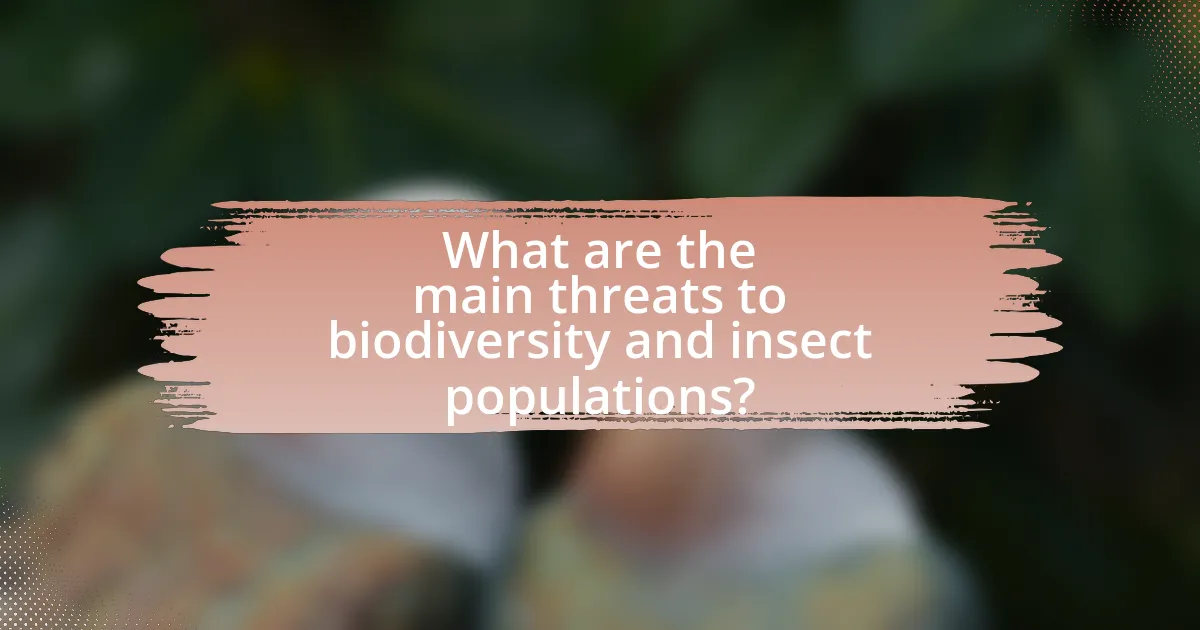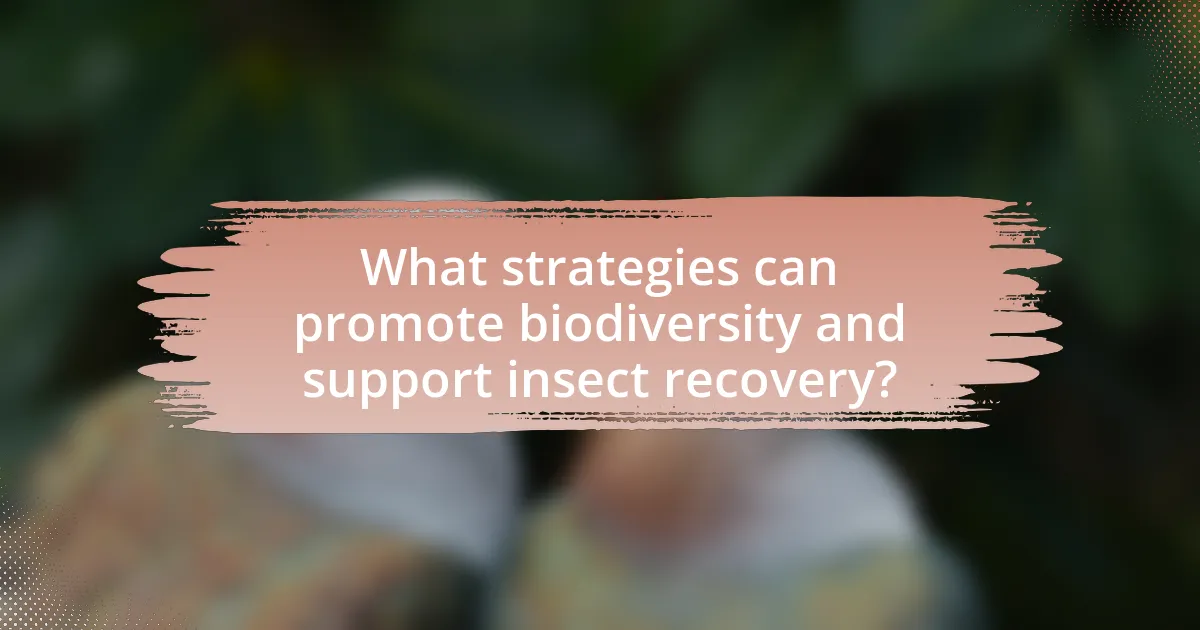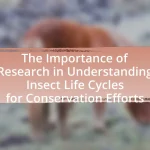The article examines the critical relationship between biodiversity and insect recovery, highlighting how diverse ecosystems provide essential habitats and resources that support insect populations. It discusses the influence of biodiversity on insect resilience, the ecological functions insects perform, and the consequences of insect decline on overall biodiversity. Key threats to both biodiversity and insect populations, such as habitat loss, climate change, and pollution, are outlined, along with strategies for promoting biodiversity and supporting insect recovery through conservation efforts and community involvement. The article emphasizes the importance of public awareness and individual actions in fostering biodiversity and enhancing insect habitats.

What is the Connection Between Biodiversity and Insect Recovery?
Biodiversity is crucial for insect recovery as it provides a variety of habitats and food sources that support diverse insect populations. High biodiversity enhances ecosystem resilience, allowing insects to adapt to environmental changes and recover from declines. For instance, studies show that ecosystems with greater plant diversity can sustain more insect species, which in turn contributes to pollination and pest control, vital for agricultural productivity. Research published in “Nature” by Cardinale et al. (2012) indicates that biodiversity loss can lead to significant declines in ecosystem services, further emphasizing the interconnectedness of biodiversity and insect recovery.
How does biodiversity influence insect populations?
Biodiversity significantly influences insect populations by providing a variety of habitats and resources that support diverse life cycles and ecological interactions. High biodiversity enhances ecosystem resilience, allowing insect populations to thrive through increased availability of food sources, such as plants and other organisms, and improved habitat complexity, which offers shelter and breeding sites. For instance, studies have shown that ecosystems with greater plant diversity can support a wider range of pollinator species, leading to increased pollination services and overall insect abundance. Additionally, diverse ecosystems can better withstand environmental stressors, such as climate change and habitat loss, which can otherwise lead to declines in insect populations.
What role do diverse ecosystems play in supporting insect recovery?
Diverse ecosystems play a crucial role in supporting insect recovery by providing a variety of habitats and resources essential for their survival and reproduction. These ecosystems enhance resilience against environmental changes and promote species interactions that are vital for pollination and pest control. For instance, studies have shown that areas with high plant diversity can support a greater abundance and variety of insect species, as they offer multiple food sources and nesting sites. Research published in “Nature” by Cardinale et al. (2012) indicates that biodiversity loss can lead to declines in ecosystem services, including those provided by insects, highlighting the importance of maintaining diverse ecosystems for insect recovery.
How does species richness affect insect resilience?
Species richness positively affects insect resilience by enhancing ecosystem stability and functional diversity. Higher species richness provides a greater variety of ecological roles and interactions, which can buffer against environmental stressors and disturbances. For instance, research indicates that ecosystems with more diverse insect populations are better equipped to recover from perturbations, such as climate change or habitat loss, due to the presence of multiple species that can fulfill similar roles. A study published in the journal “Nature” by Cardinale et al. (2012) found that increased biodiversity leads to improved ecosystem functioning, which directly correlates with the resilience of insect communities. This evidence supports the conclusion that greater species richness contributes to the overall resilience of insect populations in the face of environmental challenges.
Why is insect recovery important for ecosystems?
Insect recovery is crucial for ecosystems because insects play essential roles in pollination, nutrient cycling, and food web dynamics. Pollinators, such as bees and butterflies, are responsible for the reproduction of approximately 75% of flowering plants, which are vital for food production and habitat stability. Additionally, insects contribute to nutrient cycling by decomposing organic matter, thus enriching soil health and promoting plant growth. Studies have shown that declines in insect populations can lead to reduced plant diversity and compromised ecosystem services, highlighting the interconnectedness of insect recovery and overall biodiversity.
What ecological functions do insects provide?
Insects provide essential ecological functions such as pollination, decomposition, and nutrient cycling. Pollination by insects, particularly bees, is critical for the reproduction of many flowering plants, contributing to food production and ecosystem health. Decomposition is facilitated by insects like beetles and ants, which break down organic matter, returning nutrients to the soil and promoting plant growth. Additionally, insects play a vital role in nutrient cycling by aiding in the breakdown of waste and organic materials, which supports soil fertility and ecosystem stability. These functions are supported by studies indicating that insect pollinators are responsible for approximately 75% of global food crops, highlighting their importance in agriculture and biodiversity.
How does insect decline impact biodiversity?
Insect decline significantly impacts biodiversity by disrupting ecosystems and food webs. Insects serve as pollinators, decomposers, and a food source for various animals; their decline leads to reduced plant reproduction, nutrient cycling, and diminished food availability for higher trophic levels. For instance, a study published in the journal “Biological Conservation” found that a 75% decline in insect biomass over 27 years correlated with a decrease in bird populations reliant on insects for food. This illustrates how the loss of insect diversity directly affects the overall health and stability of ecosystems.

What are the main threats to biodiversity and insect populations?
The main threats to biodiversity and insect populations include habitat loss, climate change, pollution, invasive species, and agricultural practices. Habitat loss, driven by urbanization and deforestation, reduces the natural environments necessary for various species to thrive. Climate change alters ecosystems and disrupts the life cycles of insects, leading to population declines. Pollution, particularly from pesticides and plastics, directly harms insect health and biodiversity. Invasive species outcompete native species for resources, further threatening local biodiversity. Agricultural practices, such as monoculture and excessive pesticide use, diminish habitat diversity and negatively impact insect populations. These factors collectively contribute to the ongoing decline in biodiversity and insect populations globally.
How do habitat loss and fragmentation affect insects?
Habitat loss and fragmentation significantly reduce insect populations and biodiversity. These changes disrupt the availability of resources such as food and breeding sites, leading to decreased survival rates and reproductive success among insect species. For instance, studies have shown that habitat fragmentation can lead to a 50% decline in insect abundance due to isolation and reduced genetic diversity. Furthermore, fragmented habitats often create edge effects, which can alter microclimates and increase vulnerability to predators and invasive species, further threatening insect survival.
What are the consequences of urbanization on insect diversity?
Urbanization significantly reduces insect diversity by altering habitats and disrupting ecosystems. The transformation of natural landscapes into urban environments leads to habitat loss, fragmentation, and pollution, which negatively impact insect populations. Studies indicate that urban areas can experience a decline in species richness, with some research showing that urbanization can reduce insect diversity by up to 50% compared to rural areas. Additionally, the introduction of non-native species and increased pesticide use in urban settings further exacerbates the decline in native insect populations.
How does agricultural intensification impact insect habitats?
Agricultural intensification negatively impacts insect habitats by reducing biodiversity and altering ecosystems. This process often involves the increased use of monocultures, pesticides, and fertilizers, which can lead to habitat destruction and fragmentation. Studies indicate that areas with high agricultural intensity show a significant decline in insect populations, with some research reporting a loss of up to 75% of insect biomass in heavily farmed regions. Additionally, the simplification of landscapes reduces the availability of food and nesting sites for various insect species, further exacerbating population declines.
What role do climate change and pollution play in insect decline?
Climate change and pollution significantly contribute to insect decline by altering habitats and disrupting ecosystems. Rising temperatures and changing precipitation patterns affect insect life cycles, reproduction, and food availability, leading to population decreases. For instance, a study published in the journal “Nature” found that climate change has resulted in a 45% decline in insect biomass in some regions over the past few decades. Pollution, particularly from pesticides and plastic waste, further exacerbates this decline by contaminating habitats and reducing food sources. Research indicates that exposure to pesticides can reduce insect populations by up to 50%, highlighting the detrimental effects of human activity on these vital organisms.
How does climate change alter insect life cycles?
Climate change alters insect life cycles by affecting their development, reproduction, and survival rates. Increased temperatures can accelerate the growth and maturation of insects, leading to more generations per season. For instance, studies have shown that warmer temperatures can shorten the larval stage of certain butterfly species, resulting in earlier emergence and altered seasonal patterns. Additionally, climate change can disrupt the synchronization between insects and their food sources, as seen in pollinators like bees, which may emerge before flowering plants are available. This mismatch can lead to decreased survival rates and population declines, as evidenced by research indicating that climate-induced changes in phenology have contributed to declines in various insect populations globally.
What types of pollution are most harmful to insect populations?
Chemical pollution, particularly from pesticides and heavy metals, is most harmful to insect populations. Pesticides, such as neonicotinoids, have been shown to cause significant declines in bee populations, which are crucial for pollination. A study published in the journal “Nature” by Goulson et al. (2015) found that neonicotinoids can impair foraging behavior and reduce reproductive success in bees. Heavy metals, like lead and cadmium, can disrupt insect physiology and development, leading to decreased survival rates. Research indicates that these pollutants can accumulate in the environment, further exacerbating their impact on insect biodiversity.

What strategies can promote biodiversity and support insect recovery?
Strategies that can promote biodiversity and support insect recovery include creating diverse habitats, implementing sustainable agricultural practices, and reducing pesticide use. Diverse habitats, such as mixed-species forests and wildflower meadows, provide essential resources for various insect species, enhancing their populations. Sustainable agricultural practices, like crop rotation and organic farming, help maintain soil health and reduce chemical inputs, which can harm insect life. Additionally, reducing pesticide use minimizes harmful impacts on non-target insect species, allowing for natural recovery and population growth. Research indicates that areas with higher plant diversity support greater insect diversity, demonstrating the interconnectedness of these strategies in fostering both biodiversity and insect recovery.
How can conservation efforts enhance insect habitats?
Conservation efforts can enhance insect habitats by restoring native vegetation and creating diverse ecosystems. These actions provide essential resources such as food and shelter, which are critical for various insect species. For instance, studies have shown that increasing plant diversity in agricultural landscapes can lead to higher insect populations, as diverse plants support a wider range of herbivores and their predators. Additionally, the establishment of protected areas and the reduction of pesticide use contribute to healthier environments, allowing insect populations to thrive. Research indicates that regions with higher biodiversity tend to support more robust insect communities, demonstrating the direct link between conservation practices and insect recovery.
What practices can be implemented in agriculture to support insect recovery?
Implementing diverse crop rotations, reducing pesticide use, and creating habitat corridors can significantly support insect recovery in agriculture. Diverse crop rotations enhance soil health and provide varied habitats, which attract beneficial insects. Reducing pesticide use minimizes harmful impacts on non-target insect populations, allowing them to thrive. Habitat corridors, such as hedgerows and wildflower strips, facilitate movement and reproduction of insects, contributing to increased biodiversity. Research indicates that farms with integrated pest management practices and diverse landscapes can support higher insect populations, thereby promoting ecosystem resilience.
How do protected areas contribute to biodiversity conservation?
Protected areas contribute to biodiversity conservation by providing habitats that protect various species from habitat destruction and human activities. These designated regions serve as refuges for endangered and threatened species, allowing them to thrive in a controlled environment. For instance, studies show that protected areas can increase species richness by up to 30% compared to unprotected regions, as they limit human encroachment and promote ecosystem stability. Additionally, protected areas facilitate ecological processes such as pollination and seed dispersal, which are crucial for maintaining healthy ecosystems and supporting insect recovery.
What role does public awareness and education play in promoting biodiversity?
Public awareness and education are crucial in promoting biodiversity by fostering understanding and encouraging conservation actions among individuals and communities. When people are informed about the importance of biodiversity, such as its role in ecosystem stability and resilience, they are more likely to engage in practices that protect habitats and species. Studies show that educational programs can significantly increase public knowledge and concern for biodiversity, leading to increased participation in conservation efforts. For instance, a survey conducted by the World Wildlife Fund found that individuals who participated in biodiversity education initiatives were 40% more likely to support local conservation projects. This demonstrates that effective public awareness and education can directly influence positive behaviors towards biodiversity conservation.
How can community involvement aid in insect recovery initiatives?
Community involvement can significantly aid in insect recovery initiatives by fostering local stewardship and enhancing habitat restoration efforts. Engaging communities in conservation activities, such as planting native flora and creating pollinator gardens, directly supports insect populations by providing essential resources and habitats. Research indicates that community-led initiatives can increase biodiversity; for instance, a study published in the journal “Ecological Applications” found that local engagement in habitat restoration led to a 30% increase in native insect populations in urban areas. This demonstrates that when communities actively participate in recovery efforts, they can create environments conducive to the survival and proliferation of various insect species.
What are practical steps individuals can take to support biodiversity and insects?
Individuals can support biodiversity and insects by creating habitats, reducing pesticide use, and planting native species. Establishing gardens or green spaces with diverse plants provides food and shelter for various insect species, which is crucial for maintaining ecological balance. Reducing or eliminating the use of chemical pesticides helps protect beneficial insects, as studies show that pesticides contribute to the decline of insect populations. Additionally, planting native species supports local ecosystems, as these plants are adapted to the local environment and provide essential resources for native insects. Research indicates that native plants can increase insect diversity by up to 50%, highlighting their importance in supporting biodiversity.


